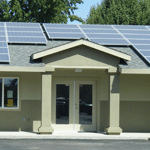Save money today, or save money tomorrow? At The Michaels Development Company, the answer is both. Instead of only using low-cost, sustainable materials during construction, the team operates under the assumption that making smart choices now contributes to reduced operating costs later, which makes long-term sustainability a reality.
Tax-credit programs increasingly require the incorporation of green practices, says Michael Boettger, the company’s vice president. But that isn’t the foundation of most of the company’s efforts. “Being affordable housing and having the lower rents than market-rate units, we typically are trying to reduce operating costs,” he says. For the team at Michaels, everything in a project, from landscaping to refrigerators, is evaluated on its long-term sustainability merits.
Before a project gets off the ground, it needs the right lending vehicle. For financing options, Boettger says that Bonneville Multifamily Capital has been a knowledgeable and innovative partner. “They do the [Section] 538 program, which is for rural housing,” he explains. It’s a loan guaranteed through the United States Department of Agriculture, and the team at Bonneville has helped Michaels to obtain it and other low interest-rate loans.
Sustainability starts at the beginning of a project, with thoughtful construction methods and materials. For example, the value of attic insulation has been increased in an effort to keep monthly heating and cooling costs low, and solar vents are used for better ventilation. One project had a central boiler that Boettger says wasn’t making the grade. “We completely abandoned that system and installed one high-efficiency hot-water tank per building, each with a circulating pump,” he says.
The surroundings also get a boost from Michaels with projects incorporating xeriscaping as a way to save money on water bills. “In a lot of the rural communities we’re in, water costs are just astronomical,” Boettger says. A recent project in Lindsay, California, was spending nearly $50,000 on water every year. After xeriscaping was adopted, those costs dropped by 30 percent.
It’s easy to be taken in by next-generation thinking, but Boettger says that a focus on long-term costs can lead to new solutions. One project originally called for a cool roof, but after crunching the numbers, the cost analysis pointed down a different path. “We knew the pricing on cool roofs was high,” Boettger says. “Our energy calculations showed that if we increased the insulation, we could achieve the same benefit for the residents at considerably less cost.”
Solar arrays are now being used in several projects, and in one southern California development it’s supporting much of the exterior lighting for the community room. “It doesn’t power the whole thing,” Boettger says of the array, “but it helps.” Because Michaels is an owner and generally tends to stay in its properties, the company has a long-term mentality. Because the solar array was powered up earlier this year, Boettger’s team doesn’t yet know its full benefits, but it’s already helping to offset costs.
Within the units, carefully selected appliances boost savings too. “All of our refrigerators, air-conditioners, heaters—everything is high-efficiency,” Boettger says, adding that properties offer energy- and water-efficient washers and dryers. “I think people need to focus on the long-term sustainability of these projects.” It’s all part of the “save today, save tomorrow” approach.

